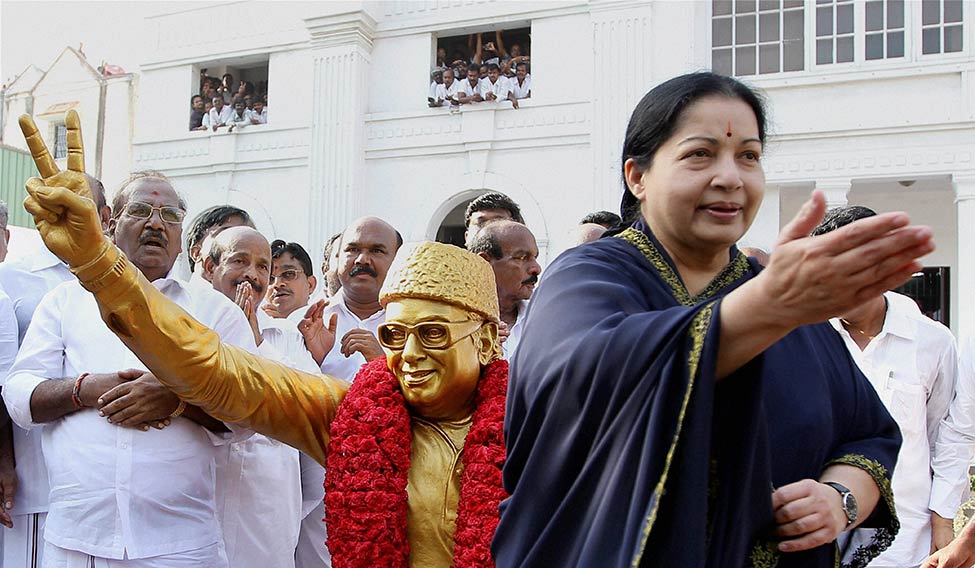How is it that when Bollywood superstars like Amitabh Bachchan and Rajesh Khanna have been such utter flops in politics, the Tamil silver screen has so long dominated the politics of Tamil Nadu?
This is not just happenstance, but deeply embedded in the politics of the Dravidian movement. The movement began in the first decade of the last century but really took off in the 1920s, when profound mass dissatisfaction at Brahmin domination first found its political voice in the Justice Party. The British were only too happy to encourage the Brahmin/non-Brahmin divide in the south as they had the Hindu-Muslim divide in the north. But while at the political level, the Congress was able to counter the Justice Party in the 1937 elections, with C. Rajagopalachari prevailing, the ideological battle was taken to another and more influential level by E.V. Ramasamy Naicker, revered as ‘Periyar’, the wise elder.
Naicker had begun his adult life as a well-versed spiritual acolyte who travelled to Varanasi to embed himself in Vedic studies and philosophy. But he ended with a profound aversion to these religious teachings and discovered in atheism and rationalism his true mission in life. Not only did he turn against all forms of religion, particularly the faith into which he had been born and reared, but he also saw the Aryan-Dravidian divide as the defining expression of his Dravidian nationalism. I once looked up the newspapers to see what was being reported on the day I was born. The headlines screamed that Periyar was on hand to welcome Jinnah to the annual session of the Muslim League in Madras, the first following the adoption of the Lahore resolution that presaged Pakistan. Periyar was entirely supportive of that resolution, but wanted it to go further to accommodate a three-way divide with Dravidanadu being added to Hindustan and Pakistan. Dravidanadu was conceived as embracing much of what was then the British-created Madras Presidency that stretched from present-day Tamil Nadu all the way to Malabar in northern Kerala and up the east coast to Behrampore in Odisha.
Pakistan happened but Dravidanadu did not, although the separation of Tamil Nadu from the Union of India remained the avowed objective of the Dravida Munnetra Kazhagam (DMK) till C.N. Annadurai renounced the objective during the India-China war of 1962. The formation in 1948 of the DMK as a political vehicle was resisted by Periyar, who felt that Dravidian ideology would be diluted by politics. Annadurai, however, was persuaded that if the Dravidian ideology was to have any practical effect, it must have a political vehicle to take on the Brahmin-dominated, Aryan-heavy, north Indian ethos-imbued Congress party. Success was achieved in the elections of 1967, and although the M. Karunanidhi-led DMK split into the M.G. Ramachandran-led AIADMK in the early seventies, the electoral victory of 1967 became the definitive divide between the Aryan-dominated politics of the pre-1967 period and the Dravidian domination of Tamil Nadu thereafter, the Congress being increasingly driven to the margins and the BJP kept out altogether.
To understand the cinematic orientation of Dravidian politics, one has to go right back to the earliest peeling off of the DMK as a political entity from the rigidly non-political but strongly ideological Dravidar Kazhagam (DK) of Periyar. Both Annadurai and Karunanidhi had strong links to Kollywood, as the Madras-based film industry came to be called in later years. Where Bollywood looked on cinema as a vehicle of mass entertainment, Anna and his colleagues quickly discovered the immense utility of cinema as a medium of political education and propaganda. They were much influenced by the enormous commercial success of the Italian film Bicycle Thief that introduced an altogether new dimension of stark realism into the fantasy storytelling of Hollywood and Bollywood. What social media is to political propagation today, cinema was to political propagation for the cine-linked leaders of the newly-founded DMK.
In quick succession, drawing on the story-spinning abilities of Annadurai and the powerful scriptwriting of Karunanidhi, cinema in Tamil Nadu was transformed into searing social analysis and highly effective radical politics. It was through cinema that the Tamil people were induced to start seriously considering an alternative political order.
The spark that transformed the influence of cinema into political power was the Shastri government’s rather foolish endeavour in 1965 to stick to the word of the Constitution and move to making Hindi the sole official language. Indira Gandhi stepped in to douse the fire—for which she always remained personally popular in Tamil Nadu—but even her intervention could not stop the Tamil electorate from turning to the DMK and decisively defeating the Congress in the 1967 election. Ever since, Tamil Nadu has turned its back on ‘national’ parties.
But differences started simmering between MGR, the most venerated actor in Dravidian cinema, and the top Dravidian scriptwriter, Karunanidhi, now chief minister. When the split came, Karunanidhi continued to carry the banner of ‘rationalism’, he and his party adhering, at least for form’s sake, to Periyar’s ferocious rejection of religion and ritual, but MGR not being so inhibited. Indeed, his leading lady Jayalalithaa combined being Brahmin-born with ostentatious devotion to temple-going and religious rites. Thus, the AIADMK tapped into the suppressed spiritual longings of the masses, who secretly yearned to return to overt idol-worship. They found their idol in MGR, who was worshipped as a god-substitute, and then Jayalalithaa, who was a goddess, period.
Now that new faces, such as V.K. Sasikala and O. Panneerselvam, unrelated to the cinema, have taken over, the air has gone out of the AIADMK balloon. Kollywood film stars-turned-politicians, like Sivaji Ganesan and ‘Captain’ Vijayakanth (and, prospectively, even Rajinikanth) have failed to convert their humongous fan clubs into political machines, because their films, as in Bollywood, were and are primarily for mass entertainment, not for the transmission of a revolutionary political message. The earlier Dravidian leaders were principally politicians who used cinema as the medium for their politics; the later arrivals are entertainers trying to cash their celebrity status into political achievement. Alas for them, the times have changed dramatically.







